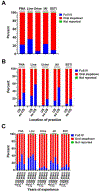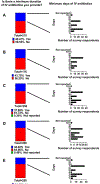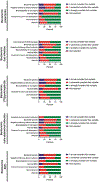Variability in oral antibiotic step-down therapy in the management of Gram-negative bloodstream infections
- PMID: 34653617
- PMCID: PMC8645249
- DOI: 10.1016/j.ijantimicag.2021.106451
Variability in oral antibiotic step-down therapy in the management of Gram-negative bloodstream infections
Abstract
There are important gaps in the literature regarding the role and timing of oral therapy for Gram-negative bloodstream infections (GN-BSIs). To better understand contemporary management practices involving oral step-down in GN-BSI, we conducted an international survey of infectious diseases (ID) specialists. We developed and disseminated an online survey to ID specialists to assess practice patterns involving oral step-down in GN-BSIs, including providers from six continents and 28 countries. χ2 tests and generalised estimating equations were used to identify factors associated with oral step-down. In total, 277 ID specialists completed the survey (64% physicians, 31% pharmacists). Relative to a line source, oral step-down was more common in abdominal [OR = 1.96 (95% CI 1.48-2.61); P < 0.001], pneumonia [2.24 (1.67-2.99); P < 0.001], skin [7.26 (4.71-11.20); P < 0.001] and urinary [9.15 (5.73-14.60); P < 0.001] sources of GN-BSI. US providers were more likely to practice oral step-down than non-US providers (OR = 4.35, 95% CI 2.57-7.36; P < 0.001). Moreover, 40% of providers practice oral step-down for some, but not all, sources of GN-BSI. Among all providers, 23-53% (depending on GN-BSI source) recommend extended (≥5 days) intravenous (IV) therapy before oral step-down or ongoing IV therapy. Most respondents (76% of all providers; 80% of ID physicians) expressed interest in enrolling patients in a trial of full IV versus early oral step-down for GN-BSI. There is extensive heterogeneity in oral step-down practices for GN-BSI. The optimal role of oral step-down in managing GN-BSIs warrants further investigation.
Keywords: Bacteraemia; Bloodstream infection; Gram-negative; Oral step-down.
Copyright © 2021 Elsevier Ltd and International Society of Antimicrobial Chemotherapy. All rights reserved.
Conflict of interest statement
Declaration of Competing Interest None declared.
Figures




References
-
- Thaden JT, Li Y, Ruffin F, Maskarinec SA, Hill-Rorie JM, Wanda LC, et al. Increased Costs Associated with Bloodstream Infections Caused by Multidrug-Resistant Gram-Negative Bacteria Are Due Primarily to Patients with Hospital-Acquired Infections. Antimicrobial agents and chemotherapy. 2017;61. - PMC - PubMed
-
- Al-Hasan MN, Lahr BD, Eckel-Passow JE, Baddour LM. Predictive scoring model of mortality in Gram-negative bloodstream infection. Clinical microbiology and infection : the official publication of the European Society of Clinical Microbiology and Infectious Diseases. 2013;19:948–54. - PubMed
-
- Al-Hasan MN, Juhn YJ, Bang DW, Yang HJ, Baddour LM. External validation of bloodstream infection mortality risk score in a population-based cohort. Clinical microbiology and infection : the official publication of the European Society of Clinical Microbiology and Infectious Diseases. 2014;20:886–91. - PMC - PubMed
MeSH terms
Substances
Grants and funding
LinkOut - more resources
Full Text Sources
Medical

